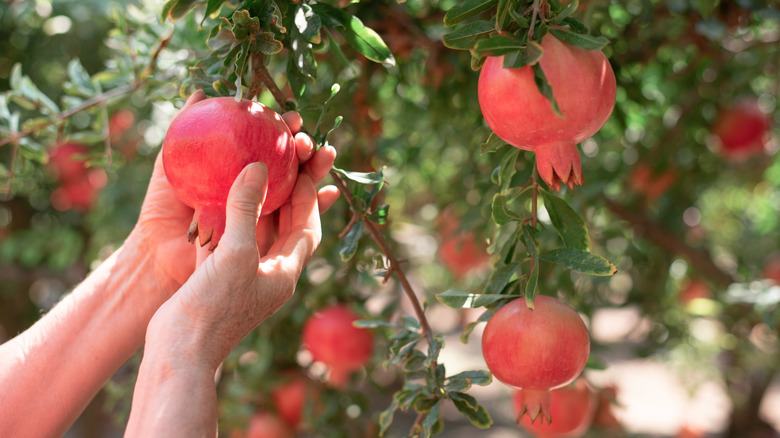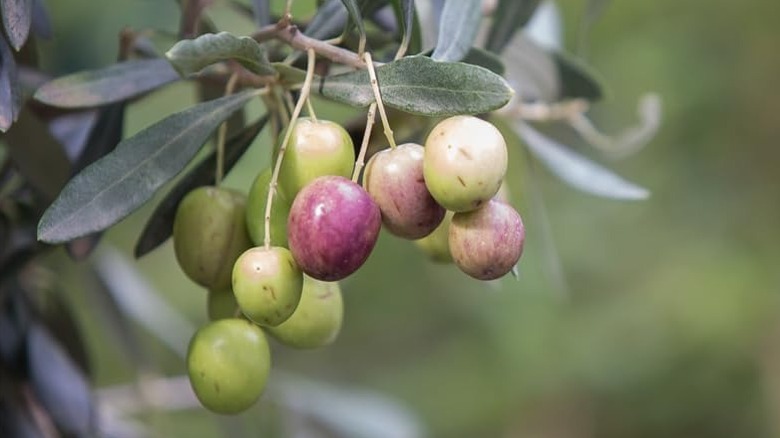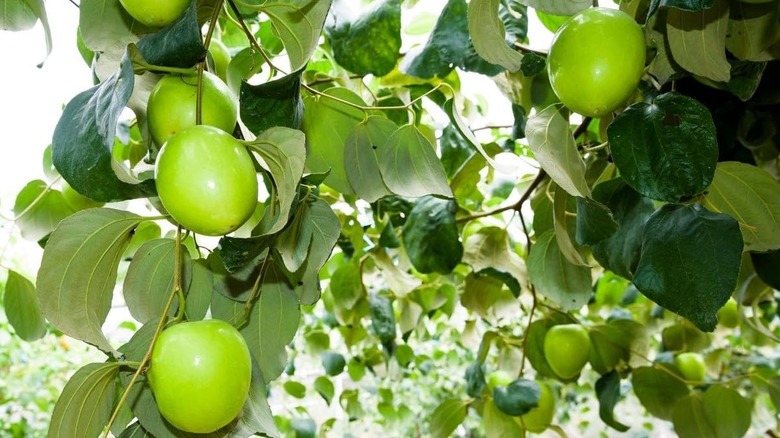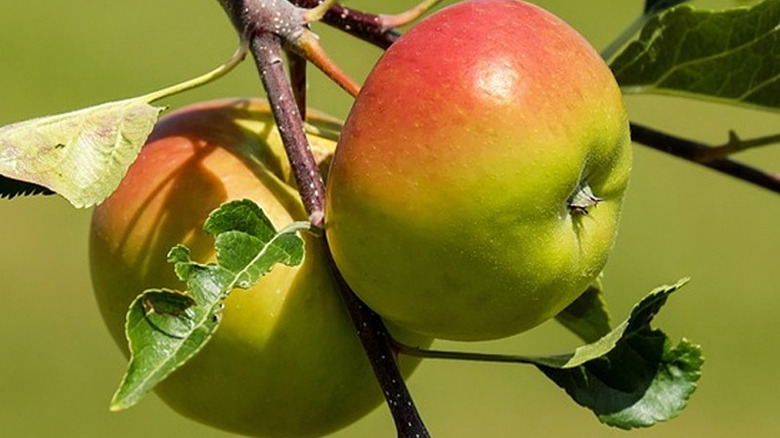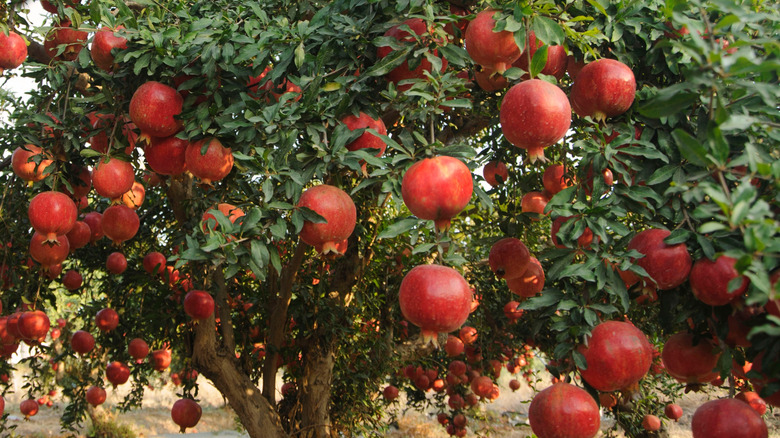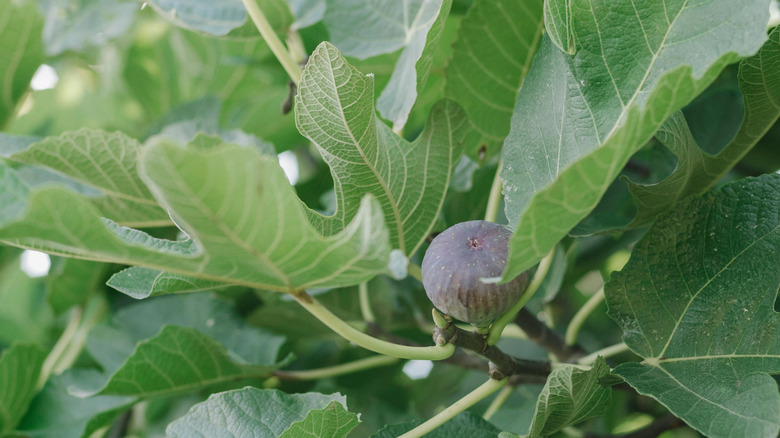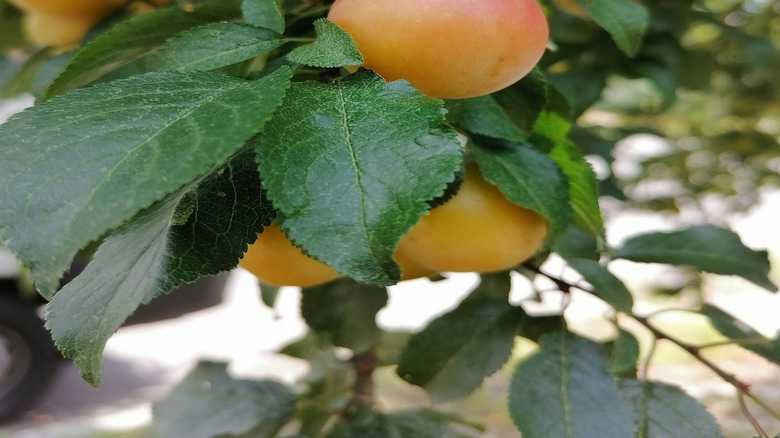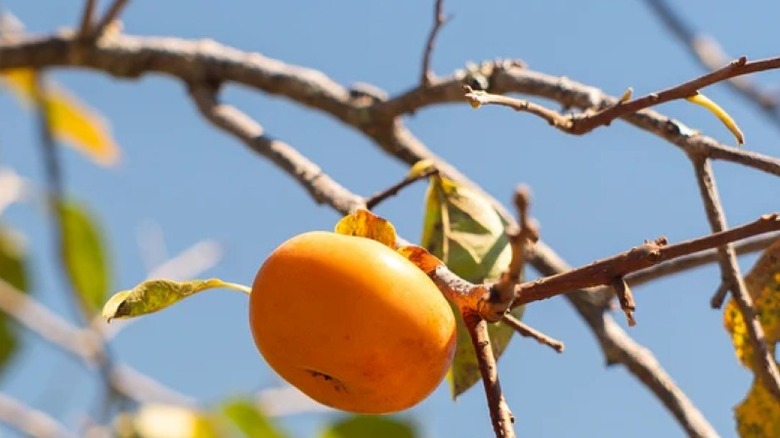8 Best Fruit Trees To Grow For Hot And Dry Climates
We may receive a commission on purchases made from links.
Gardening in hot, dry locales can be challenging and hard on your water bill, especially if you want to produce some homegrown food. Fruit trees can be tricky to cultivate even under ideal conditions, which ups the ante even more. Fortunately, there are a few fruit trees that have adapted on their own or through special cultivation to survive in the dry climates of the southwest and which tend to be drought-tolerant. Some of these species, such as stone fruits, can develop pest and disease issues in damp, humid conditions, which makes dryer zones a good place to try your hand at cultivating them. Others originate in arid areas in Europe and the Middle East and have drought-tolerance baked into their genetics.
Below are eight fruit trees that are growable in hot areas that don't receive a lot of rainfall. Unlike plants you should never grow in dry climates, these species are mostly better off in such conditions. They may not produce fruit as often or as plentifully as they would in more temperate regions, but this is an unavoidable truth of nature. In a University of Illinois study, drought stress reportedly reduced all fruit tree harvests in the following years. The main difference with the trees in this list is that they're able to survive dry periods and produce edible, good-tasting fruit despite the hardship.
Read on to learn how these trees have adapted or been cultivated to withstand droughts. You'll also learn which varieties are more resilient and other growing tips that will improve your chances of success. By picking the right species and avoiding the common mistakes everyone makes when growing fruit trees, you can enjoy homegrown harvests, even in a hot and arid area.
Olive trees grow in climates that mirror long and hot Mediterranean summers
Olive trees hail from the Mediterranean, where they face long, hot, dry summers and mild winters. Given their native land, they are moderately well-suited for drier climates and only need deep watering once per month after they've established their root systems. Their leaves are waxy with tiny hairs on the underside that reduce transpiration, helping them retain water during times of drought.
Although olive trees thrive in relatively hot weather, they don't withstand extreme temperatures in either direction, which makes them difficult to grow in places that face both excruciating heat and freezing snow. Deserts are too intense, as temperatures below 25 degrees Fahrenheit are detrimental, especially for young trees. However, olive trees will grow in certain areas throughout Arizona, California, and Texas as long as they're protected during frost periods.
Olive trees do best in Zones 8 through 10, namely the southern United States. They withstand severe droughts in these areas, though they may skip a year of fruiting. To set flowers, olives require cool nights paired with warm days, and temperature swings during this time could affect yields. However, as long as they get two months of 40 to 50-degree weather during winter, they should provide olive harvests. If you're looking for an attractive shrub to round out the planting, olive trees thrive alongside lavender, another garden plant renowned for its drought tolerance.
Jujube trees tolerate droughts and saltwater exposure due to their deep root systems
Jujube trees have been domesticated for thousands of years but have only recently started gaining traction in the United States. These resilient fruit trees have small glossy leaves and deep root systems that conserve water in periods of hardship. Certain cultivars, like the Qiyuexian, can even handle increases in the salt content (salinity) of their soil. Too much salt usually absorbs moisture and directly dehydrates a plant. Less tolerant fruiting trees can't fight increased salinity levels as they become incapable of carrying out photosynthesis and will suffer as a result. Seeing as jujube trees can even fight this level of dehydration, it's unsurprising that they're strong survivors of hot and dry climates.
They have potential in USDA Zones 6, 7, 8, and 9. They enjoy both full sun and partial sun, and do well in slightly alkaline to acidic pH ranges and a variety of soil types. As long as the soil is well-draining, the trees will push to survive. Depending on the cultivar, they also tolerate a wide range of temperatures between 20 to 120 degrees. We looked into two studies on jujube trees, which took place in Utah and Florida (conducted by the Utah State University and the University of Florida, respectively). These states have severely different humidity levels throughout the year but still successfully grew jujube trees, proving these plants also have a high tolerance for arid to tropical conditions. If the jujube piques your interest, plant more than one to get your jujube tree to produce more fruit.
Multiple peach tree cultivars survive dry conditions once established
Peaches may have a soft pink and fuzzy exterior, but they're more resilient than they look. In temperate climates, peaches don't need much watering aside from natural rain, as long as they get about an inch of water every 10 days. As long as these fruit trees get sufficient water while growing into maturity, they can survive harsher conditions in their harvestable years. For instance, in Arizona's low desert, several peach cultivars can be successfully grown. These peaches are usually early-fruit varieties (which ensures the fruit can mature before the full blast of summer heat), and include 'Bonanza Miniature', 'Desert Gold', 'Earligrande', 'Flordaprince', and different 'Tropic' varieties. If grafted with the right rootstocks, these cultivars can demonstrate improved drought tolerance and require fewer chill hours. Certain species, like the 'Desert Gold', have been successfully grown in California's deserts, showing how peaches don't just survive but thrive in such climates. 'Earligrande' hails from Texas and can successfully be grown in Arizona, further assuring that this orchard staple can be healthy and fruitful in states prone to drought.
The aforementioned peach cultivars are ideal for Zones 6 through 10 and should be planted somewhere that receives direct sun for six to eight hours per day. Plant saplings atop hills or higher elevations since cold air moves downward, and there's less risk of other trees or buildings obstructing sunlight. Peach trees aren't super picky when it comes to soil, but they do best in well-draining sandy loams with neutral pH levels. Their climate preferences vary since different cultivars have been bred to withstand conditions in various areas of the United States. However, the varieties mentioned above have proved to perform well in more arid settings and have mostly low chill hour requirements, ranging between 100 and 250 hours.
Another perk of growing peach trees is that they can survive on greywater, which is household wastewater that's used to irrigate gardens. Although they can handle dry climates, they do require a good amount of water to bear bountifully. If you live in a state prone to droughts, installing a greywater system can help ensure your trees prosper and produce fruit year after year.
Several apple tree varieties have successfully grown fruit in Arizona's low desert
Apples are among the most popular fruits produced in the United States, so it's no shock that they've been cultivated to survive in places prone to droughts and dryness. There are several cultivars that can produce bountiful harvests in low desert areas. 'Anna', 'Beverly Hills', 'Ein Shemer', 'Golden Dorsett', and 'Gordon' apples are so tolerant they can not only survive the hot and dry climate of Arizona, but also successfully produce edible fruit. The rootstock is a major player in these apple trees' survival. Full-size trees on standard or semi-dwarf rootstocks have deeper root systems that help them survive droughts. Full-size trees also produce less fruit in relation to tree size than dwarf trees, therefore giving them more energy to use for survival rather than supporting large harvests. Growing less fruit is also beneficial for transpiration reasons. Essentially, trees transpire more through fruits, which increases water loss and decreases drought tolerance.
Most of the aforementioned apple trees do best in USDA Zones 6, 7, 8, and 9, though the 'Gordon' apple can be planted in Zone 4. They flourish in full sun and enjoy neutral to slightly acidic soil. Most of these cultivars aren't picky about their soil pH level, but pH can become an issue when severe droughts occur. There is a condition called drought spot that shows on fruiting apple trees. This condition is sparked by a boron deficiency, which is common in sandy soil with little moisture and pH levels that are too acidic or alkaline. Drought spot is unstoppable once physical symptoms pop up, but it's a good warning to optimize how you grow and care for apple trees by adding boron fertilizer like Boron 20% Micronutrient Fertilizer in future years.
Pomegranate trees thrive in hot weather and are called the jewels of the desert
Pomegranate trees are believed to originate from the Middle East, a land known for its arid deserts that exceed 100-degree temperatures during the summer. Due to their hardy nature, pomegranates have spread throughout many other parts of the world, including China, Greece, India, and the Mediterranean. In the United States, pomegranates thrive throughout the California Central Valley and nearby states with desert-like conditions. In fact, their heat tolerance is so high they are most fruitful in areas with temperatures above 85 degrees for a third of the year. These plants mainly do better in dry areas, because the fruits don't fare well in summer rain. Too much water softens and splits them open, making wetter climates counterproductive.
Unlike many other drought-resistant fruit trees, pomegranates aren't tolerant of a wide variety of growing zones. It's suggested that pomegranates be grown in Zones 8, 9, and 10, with only specific varieties being able to survive colder northern states. Even though pomegranates love the heat of southern states, you should be wary of planting them in places with high humidity. Many gardeners struggle with fungal growth and the aforementioned split fruit in humid areas. Climate considerations aside, pomegranate trees grow fairly well in a range of loam, sand, and clay soil types with moderately acidic to slightly alkaline pH levels. Their preferred neutral pH levels are more common in soil in humid regions – as dryer areas tend to have more alkaline soil. If your soil tests over 7.2 pH, you may need to add acidifying agents to properly balance the earth for healthy pomegranate trees. Some of the ways you can make your soil more acidic are by adding elemental sulfur (such as Earth Science's Fast Acting Sulfur), nitrogen-based fertilizers (like Urea Fertilizer 46-0-0), or aluminum sulfate (such as Hi-Yield Aluminum Sulfate).
Fig trees produce better fruit in hot, dry Mediterranean climates
If a plant doesn't do well in wet climates, it's only logical that it probably performs better in drier circumstances. Fig trees tend to prefer dry conditions while fruiting, and have been cultivated into over 700 varieties throughout the world. However, some varieties produce tough fruit that falls prematurely during hot and dry weather, so it's important to seek out types that are specifically cultivated to be more drought-tolerant. Keep in mind many fig trees have multiple names, so you may find the same cultivar under several different titles. The 'Black Mission' fig was developed for Spain's climate, which is characterized by its hot and dry summers. Therefore the 'Black Mission' fig is a drought-tolerant variety that grows in California, Arizona, West Texas, and other states with Spain-like climates.
Fig trees don't have the same characteristics as other drought-tolerant plants, as they prefer limestone soil and shouldn't be planted in sand. Figs aren't highly picky when it comes to pH levels, but try to keep the soil slightly acidic at around 6 to 6.5 pH. Be wary if you don't live in climates that emulate their Mediterranean or Middle Eastern homelands. Heavy rain and high humidity cause fruit to split and make fig trees more susceptible to insects and disease. Like most fruiting trees, they perform best in full sun. Although figs don't need rich soil (which triggers lots of lush growth and poor fruit yields), they may require conservative feeding in spring with a balanced fertilizer.
Apricot trees are more susceptible to rain than they are to droughts
Apricot trees don't mind some dry heat and are known to produce large amounts of fruit, even in arid climates like California, Nevada, and Utah. A 2000 study published in Scientia Horticulturae showed that apricot trees have some xeromorphic characteristics, as they can withstand stressful drought periods while still producing small fruit yields. Several cultivars do especially well in desert climates, and gardeners have had anecdotal success growing 'Gold Kist' and 'Katie' varieties in Arizona.
Cultivating apricot trees in drier climates has its perks. It allows you to avoid many issues that are more common in wetter growing zones. Summer fog and high humidity are detrimental, as apricot trees are vulnerable to fungal diseases. Since they bloom so early, they're also susceptible to frost and rain later in the year. Their affinity for hot dry summers and intolerance of humid conditions and waterlogging make them a great tree to try in more arid areas.
Standard apricot trees do best in USDA Zones 5, 6, and 7. 'Gold Kist' apricots prefer Zones 7 through 10, and 'Katie' apricots are more fruitful in Zones 5 through 9. You can also try a variety like 'Garden Annie,' a natural dwarf cultivar often grafted onto dwarf rootstock, which does well in Zones 6-9. Full sunlight for at least six hours a day is ideal, and they enjoy loamy and sandy soils. Some sources recommend clay for apricot trees, however, they can struggle in very heavy soil. Although apricot trees don't like overly wet conditions, you will need to irrigate your trees if you live in an arid area and want to get good yields. Regular, deep water is especially important when trees are young. Once they mature, two of the key times to water include as the fruits are reaching their full size and post-harvest. Failing to water at these points will reduce the size of the current season's fruits, and compromise next year's harvest.
Persimmons will withstand droughts thanks to their deep roots and the right varieties can grow in arid areas
Germinating and growing a persimmon fruit tree from seed is highly rewarding, as the fruits have a blended sweet and tart flavor unlike any other.The persimmon is known for its drought resistance, which Maureen Wright, master gardener and tree expert, told Homes & Gardens can be attributed to "its deep-reaching roots that tap into underground water sources. Its waxy leaves also reduce water loss through transpiration, enabling it to withstand long periods of drought." There is a catch, though. While persimmons can tolerate drier conditions, the general rule of thumb is that they don't like blazing summer temps, and prefer mild temperate to subtropical climates — not deserts.
Jeff Schalau, director at the Arizona Cooperative Extension, advises planting oriental varieties in desert-like areas (provided the temperature doesn't drop below 10 degrees Fahrenheit) since they're more resilient and still produce tasty fruits. 'Eureka', an oriental persimmon cultivar, is often grown in Texas and cultivated in the south. 'Hana Fuyu' has remarkable drought and frost resistance that makes it great for hot summers and frozen winters alike. 'Hachiya' is another hot weather favorite, can tolerate cold temps if grafted onto a native persimmon rootstock, and is commercially cultivated in California. If you want to try your hand at growing a native variety, then Texas persimmon (Diospyros texana) is probably your best bet. Originating in the Lone Star State, it has very low water requirements and tolerates heat well. On the cons side, the fruits have a lot of seeds and you will need a male and female tree to get fruit.
Native persimmon varieties are grown throughout most of the United States in Zones 4 through 9. Asian persimmons tend to do best in Zones 7 through 10, depending on the cultivar. In most zones, persimmons thrive in full sun in soils of all kinds as long as the salinity levels are low. And while persimmons can tolerate dry periods, for full-size fruit you will probably need to irrigate in arid areas.
